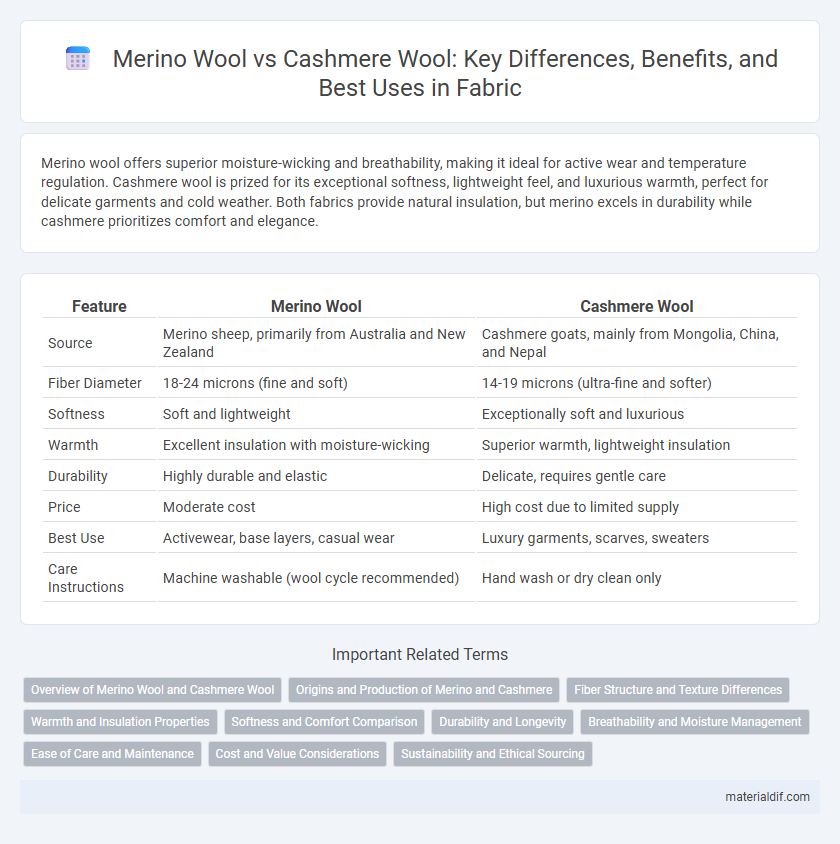Merino wool offers superior moisture-wicking and breathability, making it ideal for active wear and temperature regulation. Cashmere wool is prized for its exceptional softness, lightweight feel, and luxurious warmth, perfect for delicate garments and cold weather. Both fabrics provide natural insulation, but merino excels in durability while cashmere prioritizes comfort and elegance.
Table of Comparison
| Feature | Merino Wool | Cashmere Wool |
|---|---|---|
| Source | Merino sheep, primarily from Australia and New Zealand | Cashmere goats, mainly from Mongolia, China, and Nepal |
| Fiber Diameter | 18-24 microns (fine and soft) | 14-19 microns (ultra-fine and softer) |
| Softness | Soft and lightweight | Exceptionally soft and luxurious |
| Warmth | Excellent insulation with moisture-wicking | Superior warmth, lightweight insulation |
| Durability | Highly durable and elastic | Delicate, requires gentle care |
| Price | Moderate cost | High cost due to limited supply |
| Best Use | Activewear, base layers, casual wear | Luxury garments, scarves, sweaters |
| Care Instructions | Machine washable (wool cycle recommended) | Hand wash or dry clean only |
Overview of Merino Wool and Cashmere Wool
Merino wool, sourced from Merino sheep, is renowned for its fine fibers, exceptional breathability, and moisture-wicking properties, making it ideal for activewear and thermal clothing. Cashmere wool, derived from the undercoat of Cashmere goats, offers superior softness, lightweight warmth, and luxurious insulation, often featured in high-end sweaters and scarves. Both fibers are natural, sustainable, and highly valued for comfort, but Merino excels in performance and durability while Cashmere prioritizes softness and luxury.
Origins and Production of Merino and Cashmere
Merino wool originates from Merino sheep primarily raised in Australia and New Zealand, known for their fine, soft fibers produced through sustainable grazing practices. Cashmere wool is derived from the undercoat of Cashmere goats native to the high plateaus of Mongolia, China, and Iran, harvested by combing during the molting season to collect the ultra-soft, insulating fibers. The production of Merino wool involves shearing the sheep annually, while Cashmere requires careful hand-combing and sorting, making it rarer and often more expensive.
Fiber Structure and Texture Differences
Merino wool features fine, crimped fibers that create a soft, breathable fabric with excellent moisture-wicking properties, making it ideal for activewear and thermal insulation. In contrast, cashmere wool is composed of longer, finer fibers from the undercoat of cashmere goats, resulting in an ultra-soft texture with a luxurious, silky feel that provides superior warmth without bulk. The fiber diameter of Merino typically ranges from 17 to 23 microns, while cashmere fibers are finer, averaging 14 to 19 microns, contributing to distinct tactile and thermal characteristics.
Warmth and Insulation Properties
Merino wool excels in moisture-wicking and breathability, providing superior temperature regulation and warmth in varying conditions. Cashmere wool offers exceptional insulation with its fine, soft fibers, creating a lightweight yet highly effective barrier against cold temperatures. Both fabrics deliver warmth, but Merino's versatility suits active wear, while Cashmere is preferred for luxurious, cozy insulation.
Softness and Comfort Comparison
Merino wool offers exceptional softness due to its fine fiber diameter, typically measuring 17-23 microns, which provides a smooth, non-itchy feel ideal for sensitive skin. Cashmere wool, derived from the undercoat of cashmere goats, has an even finer fiber diameter of 14-19 microns, resulting in a luxuriously soft texture that surpasses most other natural fibers in comfort. While both fabrics excel in warmth and breathability, cashmere is often preferred for its ultra-soft, lightweight comfort, whereas merino wool provides durable softness with excellent moisture-wicking properties.
Durability and Longevity
Merino wool offers superior durability due to its fine, yet strong fibers that resist pilling and maintain shape over time, making garments long-lasting with regular use. Cashmere wool, while exceptionally soft and luxurious, tends to be more delicate and requires gentle care to prevent fiber breakage and wear, limiting its longevity compared to merino. The natural resilience of merino fibers supports sustained durability, whereas cashmere demands more careful handling to preserve its quality over extended periods.
Breathability and Moisture Management
Merino wool excels in breathability and moisture management due to its natural crimp structure, which allows air circulation and wicks moisture away from the skin, keeping wearers dry and comfortable. Cashmere wool, while soft and insulating, has lower moisture-wicking capabilities and breathability compared to Merino, making it less effective for active or warm-weather wear. The superior moisture regulation of Merino wool makes it ideal for performance fabrics and outdoor apparel.
Ease of Care and Maintenance
Merino wool is easier to care for due to its natural elasticity and resistance to odors, often requiring only gentle washing and air drying to maintain its shape and softness. Cashmere wool demands more delicate handling, including hand washing with specialized detergents and flat drying to prevent damage and preserve its luxurious texture. While both fabrics offer exceptional warmth, Merino's durability and simpler maintenance make it a practical choice for everyday wear.
Cost and Value Considerations
Merino wool and cashmere wool differ significantly in cost, with cashmere typically commanding higher prices due to its rarity and labor-intensive harvesting process. Merino wool offers excellent value by combining affordability with superior breathability, moisture-wicking, and durability, making it ideal for activewear and everyday garments. While cashmere provides unmatched softness and luxury, its higher cost reflects limited supply and delicate care requirements, often positioning it as a premium investment in cold-weather apparel.
Sustainability and Ethical Sourcing
Merino wool is often considered more sustainable than cashmere due to sheep's lower environmental impact and more efficient land use compared to goats for cashmere. Ethical sourcing of merino wool emphasizes animal welfare and regenerative farming practices, reducing the carbon footprint and promoting biodiversity. Cashmere production faces challenges related to overgrazing and land degradation, making responsible sourcing and certification crucial for its sustainability.
merino wool vs cashmere wool Infographic

 materialdif.com
materialdif.com